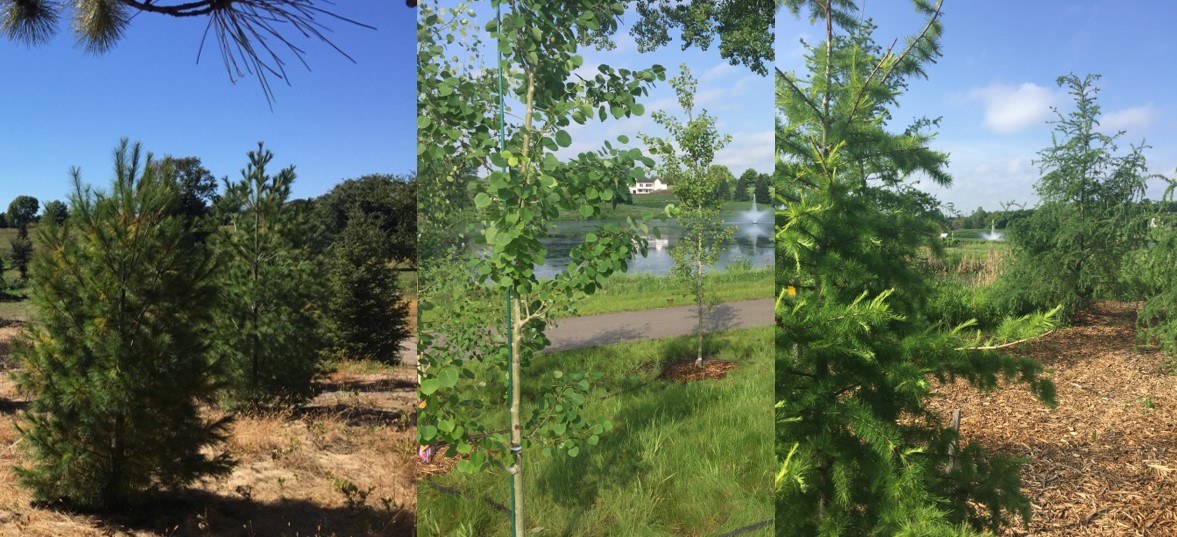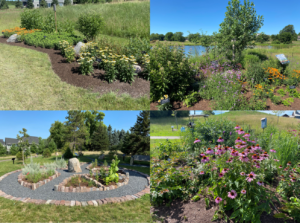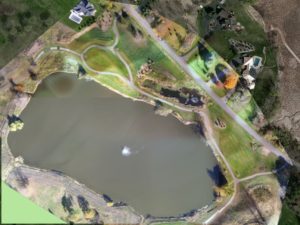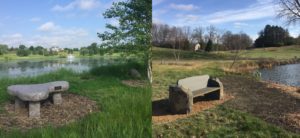
TRAILS extend throughout the park and can be accessed at two points on North Arm Drive. They are the same width as the original golf cartways and connect with those of the residential community. A small parking area is available near the southern access point along North Arm Drive. Most of the golf course turf was replaced by a lower maintenance native fescue mix though parts of it along the trails will be mowed periodically, providing contrast with adjacent prairie and wetland areas – and a hint of the old golf course.

Over eighty-five native TREES have been planted including white and red pine, balsam fir, black spruce, quaking aspen, tamarack, red and sugar maples, swamp white and pin oaks, river and paper birch, poplar, hackberry, mountain ash, and even a Kentucky coffee tree. Signs provide information about each species, including when and how they were planted.
Six natural stone BENCHES have been donated and placed at scenic locations along the pond and overlook points on the north and south sides. Each one has been surrounded by trees and/or plants to create a special contemplative atmosphere. There are also several sitting stones in the tamarach grove adjacent to the wetland.
 Several PERENNIAL GARDENS, all based on native flowers and shrubs are now a recurring part of the park. During the summer of 2017 an interpretive garden of 140 native perennials (lower right) and a lepidoptera habitat (upper right) containing trees, shrubs and plants that support the entire butterfly life cycle were planted in two different locations. In 2018 a garden of native perennials, optimized for seasonal color, (upper left) was added in the “loop” area of the park. From the first yellow jonquils in spring to the last purple New England asters in late fall the garden features a burst of intense color throughout the growing year. During 2019 and 2020 a Medicine Wheel was constructed of cobblestones and planted with four of the most sacred Dakota medicinal herbs: Prairie Sage, Sweetgrass, Cedar, and Native Tobacco. The Medicine Wheel is part of an area dedicated to Native Americans that looks out over the Park from the north.
Several PERENNIAL GARDENS, all based on native flowers and shrubs are now a recurring part of the park. During the summer of 2017 an interpretive garden of 140 native perennials (lower right) and a lepidoptera habitat (upper right) containing trees, shrubs and plants that support the entire butterfly life cycle were planted in two different locations. In 2018 a garden of native perennials, optimized for seasonal color, (upper left) was added in the “loop” area of the park. From the first yellow jonquils in spring to the last purple New England asters in late fall the garden features a burst of intense color throughout the growing year. During 2019 and 2020 a Medicine Wheel was constructed of cobblestones and planted with four of the most sacred Dakota medicinal herbs: Prairie Sage, Sweetgrass, Cedar, and Native Tobacco. The Medicine Wheel is part of an area dedicated to Native Americans that looks out over the Park from the north.

